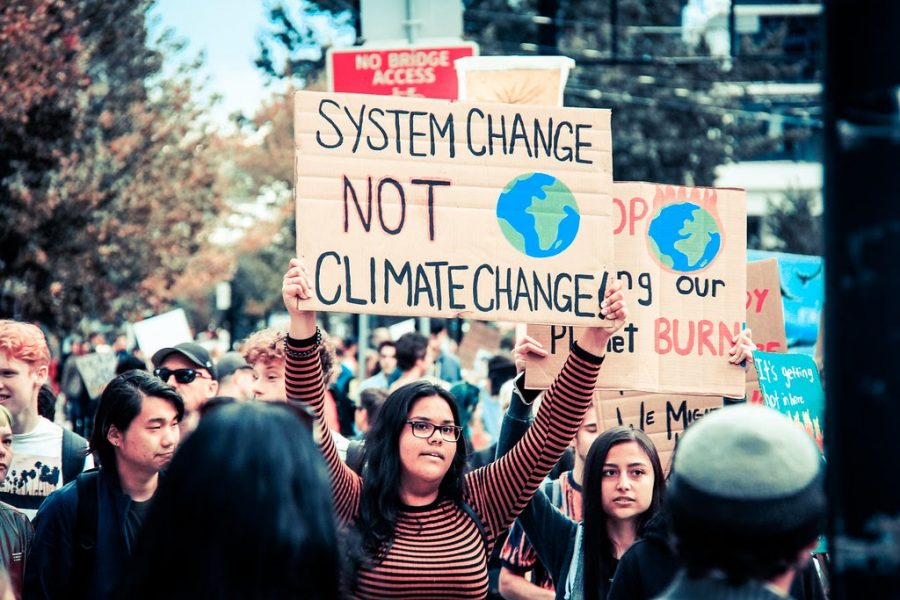My issues with Earth Day, and corporate adoption of environmentalism
Earth Day, in theory, should be great. The official Earth Day website states that the first Earth Day was held on April 22nd, 1970, when 20 million Americans took to the streets in nationwide protests. These demonstrations were against industries polluting the environment through practices such as oil spills, destruction of forests and wildlife, pesticides, and more. Coordinated by environmental activist Denis Hayes, these protests led to the creation of the Environmental Protection agency, and the passage of laws to protect the environment, such as the Clean Air Act. The holiday became celebrated internationally in 1990, and to this day, is recognized across the globe each year.
People uniting to advocate for a better planet and holding corporations accountable is great, and a cause worth celebrating. Many communities organize events that help the planet to celebrate, and the holiday is also often kids’ first introduction to caring about the environment, making it a great learning moment.
However, in recent years, the day has been taken over by large corporations as a marketing opportunity in hopes of improving the public perception of their environmental policies. Some switch to paper bags, or others may create a clothing line with sustainable cotton. If these changes were significant and long-lasting, then these Earth Day initiatives would be great. But the reality is that most of these companies only have sustainable practices and products on Earth Day, and continue abhorrent treatment towards the environment and their workers during the remainder of the year. The appropriation of Earth Day has shifted it from a day of people taking action against harmful business practices to one of consumerism. This marketing practice is called greenwashing, defined as a tactic to deceive consumers into believing organizations are environmentally friendly. Here is how you can spot greenwashing companies, and some alternatives to opt for instead to help our planet, on Earth Day and everyday.
By now, most people know the importance of taking care of the environment. Practices like deforestation result in loss of habitat, soil erosion, and contribute to climate change. The large increase of greenhouse gas emissions released from burning fossil fuels causes Earth’s atmosphere to trap more heat and increase global temperatures. The destruction of the environment will have disastrous consequences if our actions continue. NASA predicts that sea levels will rise 1-8 feet by 2100, displacing many people from their homes. Weather will become more extreme, with worse droughts, heat waves, and hurricanes, impacting agriculture and causing damage through more natural disasters.
In order to stop this, we are often told to conserve energy; walk more, turn off the lights when you leave, recycle, or turn off the tap when brushing your teeth. And while these small individual actions are nice, it skirts around the truth of what is really causing so much damage to our planet. The Carbon Majors Report states that since 1988, over 70% of the world’s greenhouse gas emissions have been released by just 100 companies. The average person is not who’s to blame for climate change, instead it’s big companies, and if we want to save the Earth, it’s most important that we start with reforms at the corporate level.
Well, luckily for us, large companies’ Earth Day initiatives should be just the thing to fix climate change, right? Nestlē, for example, has dedicated their website to talking about their sustainability plans, stating their goal to half their greenhouse gas emissions by 2030. Emma Keller, the company’s head of sustainability, wrote a piece for the website this April called “This Earth Day, we’re talking about Climate Change,” boasting of plans to reduce plastic packaging and give back to their farmers. Ignore the fact that in 2018, Nestlē bottled 45m gallons of spring water from Strawberry Creek, a water source on federal land in California. As reported by The Guardian, this effectively impaired the stream and dried up some of its creek beds, while Nestlē Water greatly profited from this destruction, making over 7.8 billion in sales worldwide that year.
Or how about their human rights violations in Africa, where countless cases have shown Nestlē sourcing their chocolate from child slave labor. Since 2005, Nestlē and other chocolate producers have promised to remove child labor from their supply chain. But as recently as October of 2020, a study by the University of Chicago funded by the U.S department of labor found that 1.58 million children are working in cocoa farms in West Africa.
Ok, then what about H&M? Their clothing line Conscious focuses on using recycled materials and natural fabrics, and their website states that currently, 65% of their materials are sustainable. Cool! Except, this doesn’t change the fact that they are still a fast fashion company, and one of the oldest businesses built on this inherently wasteful model.
Fast fashion is cheap (both in quality and price) clothing produced rapidly on a massive scale, keeping up with each fashion trend or season. These clothes are not designed to last; they are built on trends that quickly go out of fashion, meant to be disposed of as soon as the new style comes around in a few months. Even if you choose to keep your pieces after the trend has ended, it likely won’t last you long; the low-quality materials and manufacturing makes these clothes more easily damaged in the wash or torn during everyday wear. While some of these clothes may get donated, many inevitably end up in landfills.
On top of that, the synthetic fabrics used are created with plastic in a process that releases harmful chemicals, and washing these textiles results in microplastics being released, eventually winding up in the ocean. Not to mention that fast fashion companies often manufacture in countries with loose labor laws, and many reports of mistreatment and unfair wages have been discovered in these factories. H&M obviously isn’t the only brand with such unethical practices, as Zara, Urban Outfitters, Forever21, Yesstyle, Shein, and more, are all guilty of this fast fashion business model.
But just because these actions are common, doesn’t mean they are excusable. According to the New York Times, in 2018 H&M produced 3 billion garments annually, inevitably contributing to the 13 million tons of clothes Americans throw out each year, as stated by the EPA. Their new “transparency” on their website for how their clothes are made do tell the name of the factory, number of workers, and location, but fail to mention wages, or if the working conditions are meeting labor standards.
These companies continue such horrible practices towards the environment and their workers all in the name of profit. Our capitalist system incentivises cutting costs wherever possible; and if that means relying on fossil fuels, polluting the land, and underpaying their workers, then that is the option companies will choose, and have been choosing for decades.
Well, that is, until now. People are more aware of the dangerous effects of climate change than ever before, and care about making things better. A study from the Pew Research Center states that in 2020, 64% of Americans believe protecting the environment and fixing climate change should be the top priority of our government, up 12% since 2010. We are realizing all of the pollution large companies create, impacting our buying habits, making the average person desire eco-friendly alternatives to unethical brands.
In order to cater to this environmentally conscious market, companies try to make themselves appear like they care, too. They still do everything they can to make the most profit, so now it’s child labor but with cotton instead of synthetics! It’s easy to be tricked into thinking you are helping the planet by buying these “eco-friendly” products, but don’t be fooled by these deceitful advertisements. This greenwashing marketing strategy is just another way to try to get your money into their pockets. Most of these companies are not genuine in their concern for the environment, and are only fighting to remain relevant in a society more and more aware of their harm.
So that brings us back to Earth Day and other initiatives companies start to make themselves more sustainable. You may feel that I am being harsh in my criticism; shouldn’t it be good that these brands are trying to do the right thing? Yes! These efforts are desperately needed. But also, not treating the planet like trash is kind of the bare minimum, especially when these are the companies responsible for so much harm. We still need to hold these businesses accountable and make sure they are truly following through with their promises, and push for them to continue their sustainability efforts even further. It’s not enough to just be satisfied with trying, as these companies are plenty financially equipped to become eco-friendly, and in a matter as serious as our planet being livable or not, we need significant, widespread action, now.
In order to save our planet we must do what we can to get unethical companies to change their ways. While environmental destruction is almost entirely CEOs’ fault, not the average person’s, that doesn’t mean we have no agency to help our ecosystem for the better. We, the people, should be the ones leading the movement for environmentalism, not greenwashing corporations with decades of wrongdoings under their belts. In my opinion, the best thing we can do is avoid these unethical businesses when possible, and focus on reforming the system to protect our environment.
Companies are driven by profit, and therefore consumers have the buying power to impact what they produce, and how they produce it. Steering clear of brands whose ethics you disagree with gives them less money to continue exploitation of resources, and incentivizes them through our dollars to make significant changes to their foul ways. This buying power can be seen in companies greenwashing marketing campaigns, but we can always push for more, and better.
But avoiding unsustainable products can be difficult, and for many people, simply not feasible, as unethical companies are often the cheapest, most convenient, and easily accessible option. The alternative, sustainable brands, can come with a hefty price and are more inaccessible to the average person. They aren’t my favorite solution to climate change due to these downsides, but for those who are privileged enough to afford more ethical options, I would recommend investing your money into these brands, as the products are often higher quality and will last you longer for your money’s worth, without hurting the environment or laborers. We can’t buy our way out environmental destruction, so what can we do?
The most impactful thing we can do is make changes to the system so we no longer have a reliance or need for unethical companies, and ensure that all manufacturing is done with our planet and our people in mind. Our economic system is rewarding pollution and destruction, thus it is fundamentally flawed and needs to be changed. Stopping reliance on fossil fuels and instead create jobs by expanding green energy, using sustainable materials in manufacturing, investing in public transit, and ending the privatization of essential services like water and energy will help us get back on track to end corporate corruption and abuse of our natural resources. Then high consumption countries must pay amends to those who have harmed by their actions through sending aid to poor countries not responsible for climate change yet are most strongly feeling it’s effects, and offering refuge to people whose homes are destroyed.
These demands may seem radical, but they must be. We are beyond the threshold of slow, gradual change. Advocating for large scale change has necessary wide scale impacts. By doing this, environmentally friendly items can become the norm, the widely available, the option for all people regardless of income, and we can prevent environmental destruction.
Our society isn’t like that currently, however, so in the meantime, the average person can still find inexpensive steps to take in our current economy to avoid unethical companies without the price of sustainable businesses. Although these alternatives can be slightly more time consuming, I’ve compiled a list of actions you can take that are fairly cheap, and sometimes even money saving, that help our planet. Celebrating Earth Day doesn’t need to end on April 22nd; many of these efforts can be taken year round. This list is by no means exhaustive, so if you are passionate about the environment, I recommend doing more research on climate change solutions, as there’s tons to choose from!
Here’s some actions you can take to help our planet:
- Advocate for change!
This is easily the most important action on the list, and the best way to make an impact. While individual lifestyle changes are great, widespread changes to how companies treat the environment is most needed, and advocacy can best achieve this. You can advocate by (once you’re 18) voting for candidates who have the best interest of the environment in mind and attending protests or demonstrations that advocate for stricter environmental protections. It’s also important to educate yourself on the issues at hand, and then informing your friends and family of things like greenwashing or unethical manufacturing practices so they can learn as well, as in order for the movement for a better planet to be successful, there needs to widespread support.
- Reduce Consumption
I know this can be difficult in our ultra-consumerist culture, but reducing the amount of things you buy and practicing thoughtful purchasing is a big step towards both lessening your spending on unethical companies and reducing the amount of items you throw out/ donate. This doesn’t mean you need to be a minimalist; by all means, buy the things you need without feeling guilty. But it is making a mental checklist before you buy something: How often will I use this? How long will it last me? Is this something that truly makes me happy? Is it a necessity or a want? This is just an example of what I think of before buying something, but your list can vary based on your values. If an item doesn’t check off 2 or more boxes, perhaps reconsider purchasing it.
- Buying Second Hand/ Hand-me-downs
Used goods are great for the environment as it prevents the object from being sent to a landfill, and doesn’t require the manufacturing energy that a new object does. Books, furniture, clothes, and more can all be found for much cheaper second hand. Good places to look are garage sales, vintage or antique shops, flea markets, and thrift stores (so long as you only take what you need and don’t gentrify). You can also look online for groups that give away free stuff, such as your local Buy Nothing group. Lastly, a great way to get new stuff and get rid of your old is trading items or giving/ receiving hand-me-downs from relatives or friends.
- Growing your own food and Farmers’ markets
Growing food at home helps the environment as most food in supermarkets are shipped from far away locations, releasing emissions, and supermarket produce is often packed in plastic containers. If you have a garden, you can also start a home compost bin, which helps avoid tossing out food scraps as well as helping your plants grow. Another solution if you don’t have yard space is shopping at farmers markets. These markets have locally grown produce that also is typically unpackaged, with the added benefit of supporting local farmers. They’re not just for produce, too; you can often find things like soap, household goods, jewelry, or baked goods, homemade by small businesses from your community.








wendy wands • May 24, 2021 at 1:03 pm
What a well written article with a lot of information! I cringe at the amount of money those in big business make all while spouting out about what they do for the environment. As with so many other issues in the US, the pay disparity is horrific and yep, the rich do keep getting richer as we stay the course with out much benefit. The environment is so important. I feel lucky that we do have a Governor who believes in Climate Change and changing the environment, but just lately he vetoed parts of an agreed policy and left out our Native Americans, those who continue to have their land taken away.
Corporate Businesses are not doing near enough to help our globe, and it makes me frightened for our future generations.
Thanks for this article, I do as much as I can at home, but I also know, it is not enough.